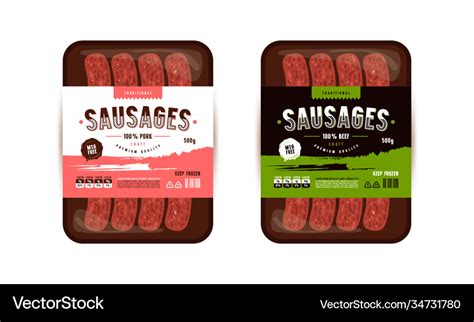Sausage Fraud: How to Protect Yourself
What is Sausage Fraud?
Sausage fraud, also known as meat adulteration, is a serious issue that involves the deliberate mislabeling or substitution of ingredients in meat products, particularly sausages. It can involve using cheaper, lower-quality meats, adding fillers and extenders, or even substituting meat with non-meat ingredients like soybeans or other plant-based proteins.
This practice can be harmful to consumers for several reasons:
- Health Risks: Sausage fraud can lead to the consumption of allergens or harmful ingredients that are not properly labeled, posing potential health risks to individuals with sensitivities or allergies.
- Nutritional Deception: Fraudulent sausages may not meet the nutritional claims on the label, leading to consumers being misled about the protein content, fat levels, and other nutritional values of the product.
- Economic Loss: Consumers are essentially paying a premium for a product they believe is of higher quality than it actually is. This can lead to economic loss for consumers who feel deceived by the misleading labeling.
- Ethical Concerns: Sausage fraud undermines consumer trust and fair competition in the food industry. It also raises ethical concerns about the honesty and transparency of food producers.
The implications of sausage fraud extend beyond individual consumers. It can also impact businesses, regulatory bodies, and the entire food supply chain.
It is essential for consumers to be aware of sausage fraud and to take steps to protect themselves from this type of deception. This article will delve into the various aspects of sausage fraud, providing information on how to identify it, what to look for, and what steps you can take to ensure you are getting what you pay for.

How Common is Sausage Fraud?
Sausage fraud is a global issue, and its prevalence varies depending on the region and the type of meat product. However, it is a serious problem that has been reported in many countries worldwide.
Studies and investigations have revealed instances of sausage fraud in various forms, including:
- Substitution of Meat: Using cheaper meats like chicken or turkey instead of the advertised meat, such as beef or pork, is a common form of fraud. This practice can significantly impact the quality and taste of the sausage.
- Addition of Fillers and Extenders: Many sausages contain fillers and extenders like breadcrumbs, soy protein, or other additives to increase the volume and lower the cost of production. While these ingredients may be safe, they are often not declared on the label, which can mislead consumers.
- Mislabeling: Some producers may mislabel sausages by claiming they are made from higher quality meats or are free of certain ingredients when they are not. This practice is deceptive and can harm consumers who rely on accurate labeling for dietary choices or religious reasons.
The prevalence of sausage fraud can be difficult to estimate accurately due to the clandestine nature of the practice. However, it is a significant problem that requires attention from both consumers and regulatory bodies.
It’s important to note that while sausage fraud is a serious concern, not all sausages are fraudulent. Many producers operate ethically and transparently, using high-quality ingredients and adhering to regulations.
However, consumer awareness and vigilance are crucial for ensuring that the sausage products we purchase are genuine and meet the standards we expect.
What are the Signs of Sausage Fraud?
While sausage fraud can be difficult to detect, there are several signs that can indicate a product may be fraudulent. Here are some things to watch for:
- Unusually Low Price: If a sausage product is significantly cheaper than other similar products on the market, it may be a sign of fraud. Be wary of suspiciously low prices, especially when comparing to brands you trust.
- Unclear Labeling: Pay close attention to the label and look for any signs of ambiguity or misleading information. For instance, if the label mentions “meat” or “meat products” without specifying the type of meat, it could be a red flag. Also, look for labels that are overly generic or lack specific details about the ingredients.
- Unusual Texture and Appearance: Sausages that are unusually dry, crumbly, or have an off-putting color may be a sign of fraud. This is especially true if the texture or appearance deviates significantly from what you would expect for the specific type of sausage.
- Strange Taste and Smell: A sausage that has an unusual or unpleasant taste or smell may indicate the use of low-quality ingredients or the presence of additives that were not declared on the label. If you notice any off-putting flavors or aromas, it’s best to avoid the product.
- Lack of Transparency: If the producer is not transparent about their sourcing and production methods, it could be a sign that they are hiding something. Look for brands that are open about their ingredients, sourcing practices, and quality control measures.
Keep in mind that these signs are not always foolproof, and some fraudulent products may appear perfectly normal. However, being aware of these indicators can help you be more vigilant when selecting sausage products.
It’s also important to note that even if a sausage product does not exhibit any of these warning signs, it does not necessarily mean it is not fraudulent. There are cases where even products that appear legitimate are found to be adulterated.
Therefore, it’s always a good practice to purchase sausages from reputable sources and to check the ingredients list carefully before making a purchase.

How Can I Protect Myself From Sausage Fraud?
Protecting yourself from sausage fraud requires a combination of awareness, vigilance, and informed decision-making. Here are some key steps you can take:
- Choose Reputable Brands: Opt for sausage products from reputable brands with a history of quality and transparency. Look for brands that have certifications, such as organic or free-range, which indicate adherence to specific standards.
- Read Labels Carefully: Always read the label thoroughly before purchasing a sausage product. Pay attention to the ingredients list, nutritional information, and any certifications or claims made on the label. Look for specific details about the type of meat used, the percentage of meat content, and the presence of fillers or extenders.
- Ask Questions: If you have any doubts about a sausage product, don’t hesitate to ask questions to the store employee or contact the manufacturer directly. Seek information about their sourcing practices, production methods, and quality control measures.
- Consider Buying from Local Sources: Buying sausages directly from local butchers or farmers’ markets can provide more transparency and control over the origin and quality of the product. You can build relationships with local producers and ask specific questions about their practices.
- Support Organizations Fighting Food Fraud: Support organizations dedicated to combatting food fraud and promoting food safety. These organizations often work to educate consumers, advocate for stronger regulations, and investigate cases of fraud.
- Be Willing to Pay a Premium for Quality: While it is tempting to choose the cheapest option, remember that a higher price often reflects higher quality ingredients, ethical sourcing, and strict quality control. Be willing to pay a premium for sausages from brands that prioritize quality and transparency.
By adopting these practices, you can increase your chances of avoiding sausage fraud and ensuring that you are getting the genuine and wholesome product you deserve.
Protecting yourself from sausage fraud is an ongoing process that requires vigilance and informed decision-making. By being aware of the signs of fraud, taking proactive steps, and supporting organizations that fight against food fraud, you can contribute to a safer and more transparent food system.
What Can I Do If I Suspect Sausage Fraud?
If you suspect you have purchased a fraudulent sausage product, there are several steps you can take to address the situation:
- Contact the Retailer: Report your concerns to the store where you purchased the product. Explain your reasons for suspecting fraud and provide any evidence you have, such as the product packaging, receipts, or photos. The retailer may investigate the matter and take appropriate action.
- Contact the Manufacturer: Reach out to the manufacturer of the sausage product and express your concerns. Provide them with the details of the product you purchased and the reasons for your suspicions. The manufacturer may investigate the issue and provide you with a response.
- Report to Consumer Protection Agencies: Contact your local consumer protection agency or the relevant regulatory authority in your country. They may investigate your complaint and take action against the manufacturer or retailer if they find evidence of fraud.
- Share Your Experience: Share your experience with other consumers through social media or online forums. This can help raise awareness about sausage fraud and encourage others to be vigilant.
- Document Your Findings: Keep detailed records of your interactions with the retailer, manufacturer, and regulatory agencies. This documentation can be helpful if you decide to take further action, such as filing a complaint or pursuing legal action.
By reporting suspected sausage fraud, you are contributing to the protection of consumers and the enforcement of food safety regulations.
It’s important to remember that you have the right to be informed and to protect yourself from misleading practices in the food industry. Don’t hesitate to take action if you suspect sausage fraud, as your efforts can help ensure a fairer and more transparent food system for everyone.
What are the Legal Consequences of Sausage Fraud?
Sausage fraud is a serious offense that can have legal consequences for both individuals and businesses involved.
The specific laws and penalties for sausage fraud vary from country to country, but generally, it can be classified as a form of:
- Food Adulteration: This involves altering the composition of food products, including sausages, in a way that is harmful or misleading to consumers. This offense can carry fines and even imprisonment.
- Mislabeling: Providing false or misleading information on the label of a food product, such as the ingredients, nutritional content, or origin, is a violation of food labeling laws and can result in fines and other penalties.
- Consumer Deception: Deceiving consumers about the true nature of a food product is unethical and often illegal. This can lead to legal actions, including lawsuits for damages or injunctions to stop the fraudulent practices.
In addition to criminal penalties, businesses involved in sausage fraud can also face civil lawsuits from consumers who have been harmed by their misleading practices.
The legal consequences of sausage fraud are significant and serve as a deterrent to individuals and businesses considering engaging in such practices. These consequences also highlight the importance of consumer protection and the need for strict regulations to ensure the integrity of the food supply chain.
What Role Do Regulators Play in Combating Sausage Fraud?
Regulatory bodies play a crucial role in combating sausage fraud by setting standards, conducting inspections, and enforcing food safety regulations.
Here are some key functions of regulators in preventing and addressing sausage fraud:
- Setting Standards: Regulatory bodies establish standards for food production, including sausage making, that specify the types of ingredients allowed, the minimum meat content, and the labeling requirements. These standards help ensure the quality and safety of food products.
- Conducting Inspections: Regulators conduct inspections of food processing plants and facilities to verify compliance with regulations and standards. These inspections may involve checking ingredient lists, production processes, and labeling practices.
- Enforcing Regulations: When violations are found, regulators have the authority to enforce regulations through fines, warnings, or even closure of facilities. These actions deter fraudulent practices and protect consumers.
- Investigating Complaints: Regulators investigate complaints from consumers or other sources regarding suspected food fraud. They may conduct further investigations to determine if violations have occurred and take appropriate actions.
- Promoting Transparency: Regulators may also promote transparency in the food industry by requiring companies to disclose their sourcing practices, ingredient lists, and other relevant information to consumers.
Regulatory bodies play a vital role in safeguarding the integrity of the food supply chain and protecting consumers from fraudulent practices like sausage fraud. Their efforts contribute to a safer and more trustworthy food system for everyone.
What Role Does Technology Play in Combating Sausage Fraud?
Technology is increasingly being used to combat sausage fraud and improve food safety.
Here are some ways technology is playing a key role:
- DNA Testing: DNA testing can be used to identify the species of meat in a product, verifying the authenticity of ingredients. This technology is particularly effective in detecting the substitution of cheaper meats or the inclusion of unauthorized ingredients.
- Spectroscopic Analysis: Spectroscopic analysis techniques can be used to analyze the chemical composition of food products, providing insights into the presence of additives, fillers, or other adulterants.
- Blockchain Technology: Blockchain technology can be used to create a transparent and secure record of the origin and journey of food products. This can help track ingredients from source to consumer, reducing the risk of fraudulent practices.
- Sensors and Monitoring Systems: Sensors and monitoring systems can be installed in food processing plants and facilities to track key parameters like temperature, humidity, and ingredient usage. This data can help identify potential deviations from standards or fraudulent practices.
- Artificial Intelligence (AI): AI algorithms are being developed to analyze large datasets and identify patterns that may indicate food fraud. These algorithms can help detect anomalies in production processes, labeling, or other areas that suggest fraudulent activities.
The use of technology is transforming the fight against sausage fraud by providing more sophisticated methods for detection, verification, and monitoring. These technological advancements are enhancing food safety and consumer protection in the food industry.
What are the Future Directions for Combating Sausage Fraud?
Combating sausage fraud requires a multi-pronged approach that involves continuous efforts from consumers, businesses, and regulatory bodies. Here are some key future directions:
- Increased Consumer Awareness: Educating consumers about the signs of sausage fraud and how to protect themselves is crucial. This can be achieved through public awareness campaigns, educational materials, and online resources.
- Enhanced Regulatory Oversight: Strengthening food safety regulations, increasing inspections, and implementing stricter penalties for violations are essential to deter fraudulent practices.
- Adoption of Technology: Promoting the adoption of advanced technologies like DNA testing, spectroscopic analysis, blockchain, and AI in the food industry can significantly enhance fraud detection and prevention capabilities.
- Collaboration and Transparency: Encouraging collaboration among food producers, retailers, consumers, and regulatory bodies is vital for sharing information, best practices, and data to combat fraud effectively.
- Ethical Sourcing and Production: Promoting sustainable and ethical sourcing practices, including fair trade and transparency in the supply chain, can help reduce the incentives for fraud and create a more responsible food system.
By working together, consumers, businesses, and regulatory bodies can create a food system that is safer, more transparent, and less susceptible to fraudulent practices. This will benefit consumers by ensuring they receive the genuine and wholesome products they deserve.
Table Summarizing Sausage Fraud
| Aspect | Description |
|---|---|
| Definition | Deliberate mislabeling or substitution of ingredients in meat products, particularly sausages. |
| Forms | Substitution of meat, addition of fillers, mislabeling. |
| Signs | Unusually low price, unclear labeling, unusual texture and appearance, strange taste and smell, lack of transparency. |
| Protection | Choose reputable brands, read labels carefully, ask questions, buy from local sources, support organizations, pay a premium for quality. |
| Legal Consequences | Food adulteration, mislabeling, consumer deception, fines, imprisonment, civil lawsuits. |
| Role of Regulators | Setting standards, conducting inspections, enforcing regulations, investigating complaints, promoting transparency. |
| Role of Technology | DNA testing, spectroscopic analysis, blockchain, sensors, AI. |
| Future Directions | Increased consumer awareness, enhanced regulatory oversight, adoption of technology, collaboration and transparency, ethical sourcing. |
FAQ
What are some examples of sausage fraud?
Sausage fraud can take many forms, but here are a few common examples:
- Using cheaper meats: Sausages labeled as beef might contain a significant amount of chicken or turkey, which are less expensive. This can significantly impact the taste and quality of the product.
- Adding fillers and extenders: Some sausages contain additives like breadcrumbs, soy protein, or other plant-based ingredients that are not declared on the label. These fillers can increase the volume and reduce the cost of production but can mislead consumers about the true meat content.
- Mislabeling the origin of meat: Sausages may be labeled as “Made in Italy” when the meat was actually sourced from a different country. This can be deceptive and may violate labeling regulations.
- Falsely claiming “organic” or “free-range”: Some sausages are marketed as “organic” or “free-range” when they don’t meet the standards for these certifications. This can mislead consumers who are looking for specific quality and ethical production practices.
Is sausage fraud a widespread problem?
Sausage fraud is a global problem, and its prevalence can vary depending on the region and the type of meat product. However, it is a serious concern that has been reported in many countries worldwide. Studies and investigations have revealed instances of fraud in various forms, including substitution of meat, addition of fillers, and mislabeling. While it’s impossible to quantify the exact extent of the problem, it’s clear that sausage fraud is a significant issue that requires attention from consumers, businesses, and regulatory bodies.
How can I be sure that the sausages I buy are genuine?
There is no foolproof way to guarantee that every sausage product is genuine, but you can take steps to minimize the risk of buying fraudulent products. Here are some key tips:
- Choose reputable brands: Opt for sausage products from brands known for their quality and transparency. Look for brands with certifications or awards that indicate adherence to specific standards.
- Read labels carefully: Always check the label thoroughly before purchasing a sausage product. Pay attention to the ingredients list, nutritional information, and any certifications or claims made on the label.
- Ask questions: If you have any doubts about a product, don’t hesitate to ask questions to the store employee or contact the manufacturer directly.
- Consider buying from local sources: Buying sausages directly from local butchers or farmers’ markets can provide more transparency and control over the origin and quality of the product.
Remember that even if a sausage product does not exhibit any warning signs, it does not necessarily mean it is not fraudulent. Being vigilant and making informed decisions is crucial for protecting yourself from sausage fraud.
What are the health risks associated with sausage fraud?
Sausage fraud can pose several health risks to consumers:
- Allergens: If a sausage product contains undeclared allergens, such as soy protein or gluten, it can trigger allergic reactions in individuals with sensitivities. This can be particularly dangerous for people with severe allergies.
- Harmful ingredients: Sausages may contain undisclosed additives or fillers that are not safe for consumption. These ingredients could be harmful to health, especially in the long term.
- Nutritional deception: Fraudulent sausages may not meet the nutritional claims on the label. Consumers might be misled about the protein content, fat levels, and other nutritional values, which can impact their dietary choices.
It is essential to be aware of these potential health risks and to purchase sausages from reputable sources to minimize the chances of encountering fraudulent products.
What role do consumers play in preventing sausage fraud?
Consumers play a crucial role in preventing sausage fraud by being informed, vigilant, and vocal about their concerns.
- Educate yourself: Learn about the signs of sausage fraud and how to protect yourself. Share this information with others to raise awareness.
- Be a discerning consumer: Pay attention to product labels, ingredients, and certifications. Don’t hesitate to ask questions about sourcing and production methods.
- Report suspected fraud: Contact the retailer, manufacturer, or relevant regulatory bodies if you suspect a product is fraudulent. Share your experiences with others to raise awareness.
- Support organizations fighting food fraud: Contribute to organizations dedicated to combatting food fraud and promoting food safety.
By being informed and taking action, consumers can help create a more transparent and trustworthy food system.
What are some steps that businesses can take to prevent sausage fraud?
Businesses have a responsibility to operate ethically and transparently to ensure the safety and integrity of their products. Here are some steps businesses can take to prevent sausage fraud:
- Implement robust quality control measures: Establish strict procedures for sourcing ingredients, manufacturing processes, and labeling to ensure accuracy and compliance with regulations.
- Adopt technology: Utilize advanced technologies like DNA testing, spectroscopic analysis, and blockchain to verify ingredients and track products throughout the supply chain.
- Promote transparency: Be open about sourcing practices, ingredients, and production methods. Provide consumers with clear and accurate information on product labels and websites.
- Engage with stakeholders: Collaborate with consumers, regulators, and industry partners to share best practices and address concerns about food fraud.
By taking these steps, businesses can demonstrate their commitment to quality, transparency, and ethical practices, building trust with consumers and contributing to a safer food system.



